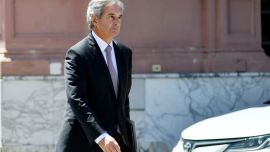Less than a month on from the passage of the RIGI large investment incentive scheme, Javier Milei’s government is excited by the first announcements and commitments. It hopes the effect will be contagious for the rest of Argentina’s economy.
Both Milei and the top tier of his economic team insist at every public appearance on the importance of injecting capital into national territory to further economic reactivation.
Earlier this week, Economy Minister Luis Caputo held a meeting with authorities from Renault Argentina after the automobile manufacturer announced a US$350-million investment that will allow the firm to produce a pick-up truck at their Santa Isabel plant in Córdoba.
Executives from the automaker highlight that the production of the new model in Argentina is within its “international game plan” – an initiative with a total budget of three billion euros to start the production of eight new vehicles in international markets outside of Europe.
Renault Argentina says the truck made in Córdoba would be the first in the Renault Group Modular Platform (RGMP) and that between 65 and 70 percent of production would be exported. The firm expects the domestic line to be ready in 18 months and to employ 850 people directly and a further 4,000 indirectly.
The French firm’s announcement follows a similar commitment from automotive manufacturer Stellantis, which will invest US$385 million to create a production park, which will also be located in Córdoba Province.
The project will see the development of a new family of vehicles, new components and a whole new engine. Hiring of workers is anticipated, of which 50 percent will be women, the firm said.
The top-selling car from the last three years in the local market is made at the Dutch multinational’s facility: the Fiat Cronos. The announcement also contemplates the relocation of “strategic supplier” Suramericana to Polo Stellantis Córdoba.
According to company sources, the arrival will help “continue in line with the objective of making the vehicles produced by Stellantis the ones with the most national content among different automakers, and that causes many local suppliers to be located in the vicinity of our Park.”
There are also developments in the energy sector.
Marcelo Mindlin, the president of Pampa Energía, on Tuesday opened a new wind farm, Pampa Energía VI, in the southeast of Buenos Aires Province – a project which demanded a US$260-million investment.
The site can produce up to 140MW, equivalent to the consumption of approximately 200,000 households.
At the inauguration were top officials leading the RIGI drive, among them Daniel González, coordination secretary of Energy and Mining and a key man in the Economy Ministry’s organisation chart.
González is at the helm of the Assessment Committee of RIGI projects and follows those adhering to the scheme closely.
In the roadmap of future investments by Pampa Energía, one of the largest energy generators in Argentina, there is a further US$1.2 billion devoted to multiplying their current oil production tenfold at Rincón de Aranda, a 240-square-kilometre exploratory block in the heart of Vaca Muerta.
The idea is to go from producing 5,000 to 50,000 barrels a day in three or four years.
For the government, the energy sector will be essential if the investment flow they intend to receive in the next two years is to materialise.
According to the calculations by Energy Secretary Eduardo Rodríguez Chirillo, US$15 billion might come in in 2025 and US$16.5 billion in 2026 thanks to the tax, customs and foreign exchange advantages of the RIGI and the ‘Ley de Bases’ mega-reform package.



















Comments